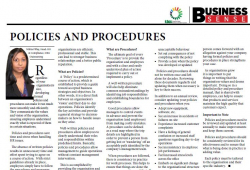Nikita Pillay - Policies And Procedures2020-03-13 Regardless of your organisation's size, developing formal policies and procedures can make it run much more smoothly and efficiently. They communicate the values and vision of the organisation, ensuring employees understand exactly what is expected of them in certain situations.
Policies and procedures save time and stress when handling HR issues. The absence of written policies results in unnecessary time and effort spent trying to agree on a course of action. With strict guidelines already in place, employees simply have to follow the procedures and managers have to enforce the policies. Implementing these documents also improves the way an organisation looks from the outside. Policies and procedures help to ensure your company complies with relevant regulations. They also demonstrate that organisations are efficient, professional and stable. This can lead to stronger business relationships and a better public reputation. What are Policies? A 'Policy' is a predetermined course of action, which is established to provide a guide toward accepted business strategies and objectives. In other words, it is a direct link between an organisation's 'vision' and their day-to-day operations. Policies identify the key activities and provide a general strategy to decisionmakers on how to handle issues as they arise. Well-written policies and procedures allow employees to clearly understand their roles and responsibilities within predefined limits. Basically, policies and procedures allow management to guide operations without constant management intervention. This is accomplished by providing the organisation and employees with limits and a choice of alternatives that can be used to 'guide' their decisionmaking process as they attempt to overcome problems. As employees are hired, it is important that they understand the correct work process to ensure that the service or product maintains high quality. What are Procedures? The ultimate goal of every 'Procedure' is to provide the organisation and employees and with a clear and easily understood plan of action required to carry out or implement a policy. A well-written procedure will also help eliminate common misunderstandings by identifying job responsibilities and establishing boundaries for employees. Good procedures allow managers to control events in advance and prevent the organisation (and employees) from making costly mistakes. A procedure can be defined as a road map where the trip details are highlighted in order to prevent a person from getting lost or 'wandering' off an acceptable path identified by the company's management team. When procedures are followed, there is consistency in practice for work processes. This helps to ensure that things are done the same way, every time and that all steps are followed. To create an acceptable policy, the following must be very carefully noted. The policy must:
When you don't enforce your procedures, you put your organisation at risk. If an employee or external person comes forward with an allegation against your company, having formal policies and procedures in place strengthens your case. As organisations grow it is important to put things in writing that the organisation values and deems important. Doing so in a detailed policy and procedure manual, that is shared with employees, can help to ensure that products and services maintain the high quality that customers expect. Important to Note Policies and procedures need to be reviewed and updated at least annually to make improvements and keep them current. Policies and procedures should be consistently reviewed for its effectiveness and to ensure that what is being done in practice is adding value. Each policy must be tailored to the organisation and their specific industry. Nikita Pillay Nikita@drg.co.za T: +27 (0)31 767 0625 W: www.drg.co.za |
Nikita Pillay - Policies And Procedures
Copyright © 2024 KwaZulu-Natal Top Business
